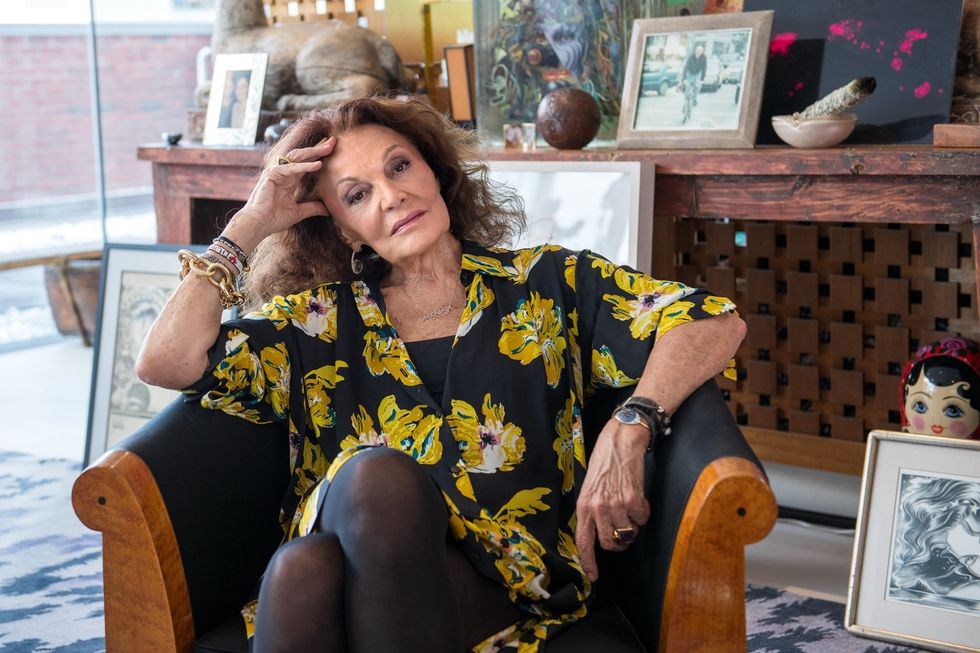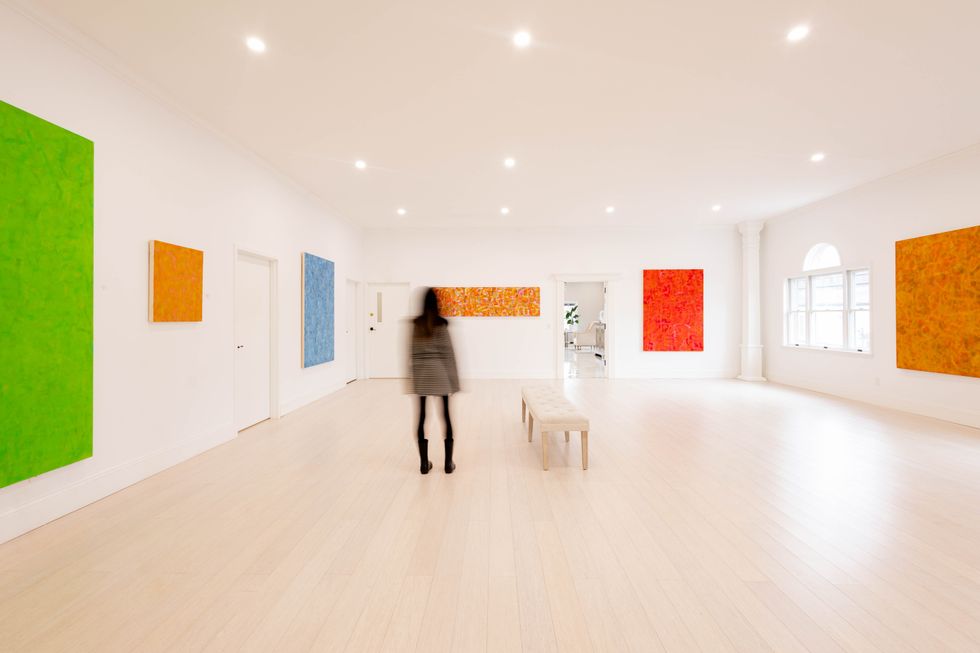Latest News
Wes Allyn slides safely into second, April 16.
Photo by Riley Klein
FALLS VILLAGE — Housatonic Valley Regional High School varsity baseball won big at home Wednesday, April 16, with a 15-3 win against Terryville High School.
Housatonic performed well on both sides of the ball. Offensively, HVRHS batters combined for 12 RBIs and seven stolen bases.
Defensively, the Mountaineers played a bullpen game and swapped pitchers at the top of each inning. Together. Wes Allyn, Carson Riva, Chris Race, Anthony Foley and Dan Moran threw seven strikeouts to win by mercy rule after five innings.

The game was played during spring break, resulting in limited rosters for both teams. Several HVRHS players went on the school trip to Europe and were touring Siena, Italy at game time.
Conditions back home in Falls Village were chilly. The sun peaked through for a moment or two, but otherwise it was overcast and 46 degrees with high winds.
Allyn pitched the first inning and held Terryville scoreless. In the bottom for the first, Foley singled and Race got walked before Hunter Conklin brought them both home on a 2 RBI double.

Riva pitched the second inning and let up one run. Offensively, HVRHS loaded the bases early in the bottom of the second and scored four runs before the inning was out.
Race brought the heat in the third inning and put the Terryville batters out in order. HVRHS did not score in the bottom of the third and score remained 6-1.
Foley pitched the fourth inning and threw two strikeouts. A series of errors in the infield loaded the bases, but Foley got out of the inning letting up just one run. HVRHS added to the scoreboard in the bottom of the inning with nine more runs.
Moran stepped to the mound for the fifth inning. One run scored, but a strikeout and two putouts ended the game by mercy rule —up by 10 or more after five innings.

Offensively, Chris Race led HVRHS with 4 RBIs. Hunter Conklin, Aidan Miller, Logan Labshere and Anthony Foley each had 2 RBIs.
For Terryville, Aiden Legassey led the team on offense with 1 RBI. Jack Rioux batted 2-for-2 and Ethan Bilodeau hit 2-for-3.
Housatonic’s season record improved to 2-3 and Terryville moved to 1-3.
The Mountaineers play the next four games on the road before returning home May 1 at 4 p.m. for a non-league game against O’Brien Technical High School.

Keep ReadingShow less
Dancers from Pilobolus will perform at the NWCT Arts Council spring fundraiser on April 26 in Washington Depot, Conn.
Provided
On Saturday, April 26, the Northwest Connecticut Arts Council will host a special evening, Arts Connected, their spring fundraiser celebrating the power of creativity and community. Held at the Bryan Memorial Town Hall in Washington Depot from 5 to 8 p.m., this event brings together artists, performers, and neighbors for a magical night filled with inspiration, connection and joy.
Award-winning designer and arts advocate Diane von Furstenberg and her granddaughter Antonia Steinberg are honorary co-chairs of the event. Their shared love of the arts informs the spirit of the evening.

“As someone whose life was profoundly shaped by the arts — as a child at Buck’s Rock and now as President of its Board — I’ve seen firsthand the transformative power of the arts; how creative spaces can empower young people, build community, and nurture well-rounded problem solvers. That’s why I’m so honored to co-host the Northwest CT Arts Council Gala. Their work in supporting artists and cultural organizations across Connecticut is essential,” said Steinberg.
Von Furstenberg’s influence in fashion and culture, and Steinberg’s leadership at Buck’s Rock reflect the intergenerational impact of the arts,” said NWCT Arts Council board president Sunday Fisher. “Their participation underscores the power of creative expression as a defining force in our community.” Steinberg is the president of Buck’s Rock Camp, a non-profit performing and creative arts camp in New Milford that she first attended as a 10-year-old camper.

Steph Burr, executive director at NWCT Arts Council, added, “Events like Arts Connected are at the heart of what we do — bringing people together, lifting up artists, and reminding us of the essential role creativity plays in our lives. The Council works year-round to ensure the arts not only survive but thrive across our region.”
NWCT Arts Council is a nonprofit that serves as advocates for the arts. Through regranting efforts, public art support, legislative advocacy, and their regional events calendar, they work to ensure the arts are accessible and celebrated in every corner of their 25-town service area.
Burr continued, “The arts in Northwest Connecticut are vibrant, evolving, and deeply rooted in community. There’s a quiet but powerful creative pulse running through these hills — one that reflects the resilience, diversity, and passion of the people who call this region home. Over the past few years, artists and cultural organizations have navigated challenges with heart and determination, despite ongoing funding volatility. Through our advocacy and collaborative programming, we ensure the arts remain essential and accessible in our community.”
Highlights of the April 26 fundraiser include performances by Pilobolus, Sherman Chamber Ensemble, Ysanne Marshall & the Lotus Blues, hand pan musician Jeremy Driscoll, and a curated art exhibition, NW25 Gallery, featuring local artists. Sponsors Litchfield Distillery, Kent Falls Brewing Company, and Executive Cuisine catering will provide the food and drink.
Ticket prices are $125, open to guests 21 and older, available online at givebutter.com/artsconnected.For more information or to ask about sponsorship opportunities, email Katherine Pelletier at katherine@artsnwct.org or visit givebutter.com/artsconnectedsponsorship.
Arts Connected is made possible thanks to the generous support of sponsors; Antonia Steinberg is sponsoring all the artists for the event and Valiant Energy and Torrington Savings Bank are presenting the event.Additional sponsors include William Raveis Lifestyle Realty, Litchfield Magazine, Housatonic Heritage, Art Bank 7, Harney & Sons Teas, Aquarion Water, The Lost Fox Inn, George Home, NKYV Rituals, and Litchfield Distillery.
Keep ReadingShow less
Lily Al-Nemri, founder and owner, and artistic director and painter Rudy Vavra at Tyte medispa and gallery in Millbrook.
Natalia Zukerman
The painter Rudy Vavra once created floor collages in Texas. You could, in theory, lie on them. Now, years later and much farther north, his work graces the walls of a medispa in Millbrook, New York where he also serves as the artistic director. You can still lie down, just not on the art. Instead, you might be undergoing an EmFace non-surgical facelift while surrounded by twenty-two of Vavra’s paintings.
The space, Tyte Medispa in Millbrook, is equal parts gallery and treatment center, the brainchild of Lily Al-Nemri, a medical aesthetician and now gallery owner. She also owns the nail salon, Bryte, down the street on Franklin Avenue. A few years ago, feeling she was outgrowing that space, she looked to expand and, just a few blocks away, found this rather sprawling maze of rooms with the gallery that now inhabits the grand central ballroom. “This used to be a gym,” she said. “It was way more than I was looking for, but I went for it.”
Vavra, a self-professed “painter’s painter,” has spent decades layering pigment in his barn-turned-studio in Milan, New York. “I find paintings as much as I make them,” he mused. “Some happen quickly, others are slow.” Of this latest collection, he said, “Some people call them busy. I think they’re slow.” His marks accumulate with a kind of devotional persistence, like petals left at a shrine. “A while ago, I saw a photographic image of a shrine,” Vavra said. “I don’t know if it was a Buddhist shrine or what, but there were colors on the ground all around it, and I realized they were the stains of flowers left in the worship. That’s very similar to the way I paint.”
The collection of paintings on view at Tyte — some as large as a shrine — are meditations on color, inviting the viewer to slow down. Or speed up. Whether viewers are activated or soothed by the images is neither Vavra’s intention nor within his control. Still, he said that watching people interact with the work has been a real treat. “Now that I have my paintings here, I get to see them all together,” he said. “It’s only when they’re all together that I see how they talk to each other. It’s interesting to see people come in and go to have a treatment and come out. It’s a very interesting connection.”
And what is the connection? What could be a disjointed pairing — aesthetics and aesthetic medicine — has become, improbably, a perfectly logical continuum. “They’re related in a sense,” Vavra said.

Al-Nemri, a former radiologist who taught for over a decade at Westchester Community College, is no stranger to layering, precision, or the quiet rigor of care. Her incredible menu of services — Botox, body contouring, pelvic floor therapies — are the cutting edge of the industry. Of Vavra, Al-Nemri said, “I fell in love with his work, and we just hit it off.” It’s a kind of kismet that seems to hover over the place. Pilates mat classes take place twice a week in the main gallery space and both Al-Nemri and Vavra have loved watching clients pause, eyes caught by a stripe of cerulean or a vibrating cluster of brushstrokes. “Something will catch their eye,” said Vavra. “They’re looking for something in it.”
So, this gallery-meets-spa (or is it the other way around?) has plans. Vavra will be curating six shows a year. Laurie Adams’s photographs will be hung in June, a group show of local artists will share the space in July and August, and a Fall show will feature twenty women artists, which Vavra is eager to anchor with a piece by Judy Pfaff. “There’s nothing like this on this side of the county,” he said of the light drenched space. “It’s been a bit sleepier here. We want to wake it up.”
He means it kindly; sleep certainly has its place. But here in Millbrook, amid the low drone of machines designed to rejuvenate, something unexpected has emerged. Perhaps that’s what both Al-Nemri and Vavra are really after — not the quick fix or the final image, but the suspended moment, the long look. A face seen anew. A painting revealed slowly, in silence.
As for Vavra’s curatorial process? “I just unpack the paintings, lean them against the wall, and look,” he said. “Eighty percent of the time, they’re already where they’re supposed to be.”
Keep ReadingShow less
loading








